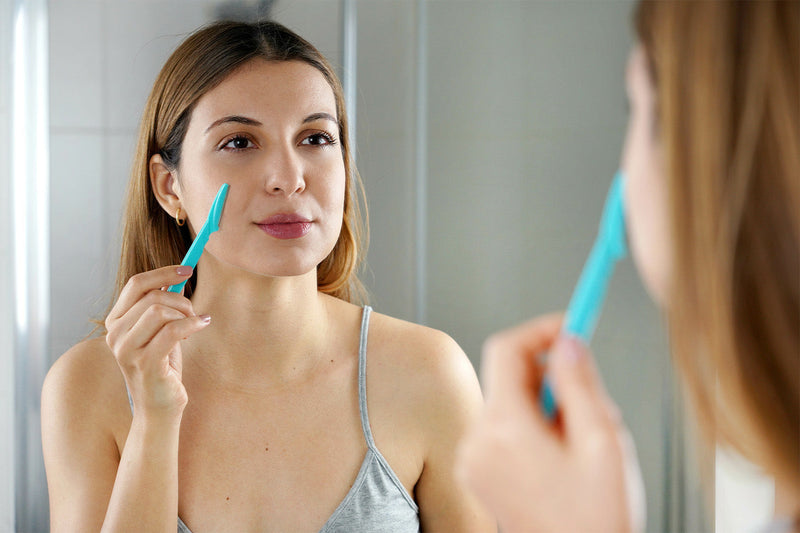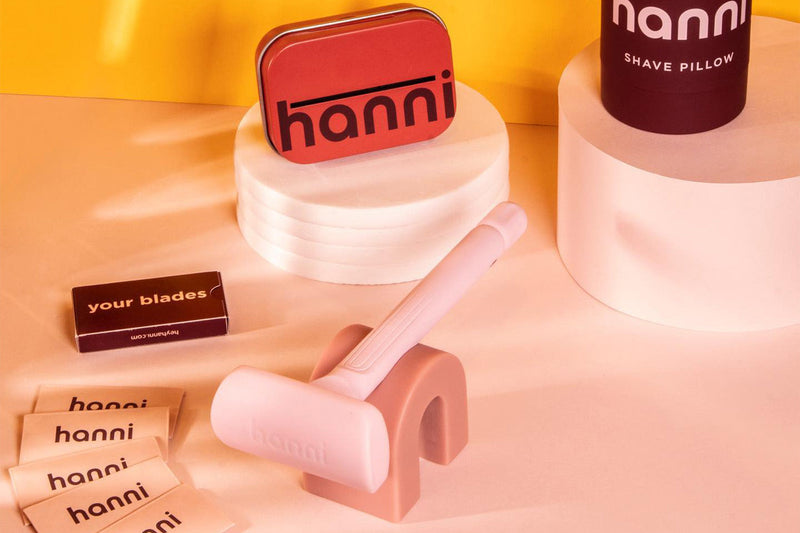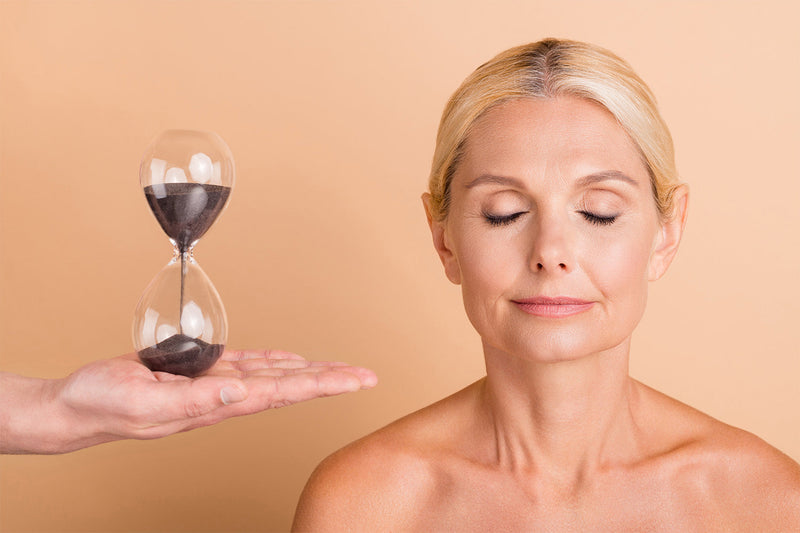Dermaplaning has become one of the trendiest hair removal techniques. We can thank its reputation for helping to reduce the appearance of fine lines, scars from acne, and other blemishes and skin conditions for its newfound popularity. This anti-aging technique can even help keep skin looking youthful and rejuvenated — honestly, what can’t dermaplaning do?
While it doesn’t completely promise young skin Forever, dermaplaning does help by exfoliating the skin to keep it looking refreshed and smooth.
So, now that you know the basics, you’re probably wondering how to get started with dermaplaning and whether this cool new skincare fad is right for you. Let’s dive into everything you need to know about stress-free dermaplaning.
Everything you need to know about dermaplaning
If you didn’t learn about dermaplaning from your dermatologist, you probably heard about it on social media. All across social media platforms, you can find countless videos of people using a single-blade razor to carefully shave their face.
You probably wondered why someone with little facial hair would be shaving their face. The truth is that dermaplaning isn’t just shaving — it’s an exfoliation technique. Most people focus on their faces when dermaplaning, but it can actually be done anywhere on the body.
Some people chose to have a dermatologist or skincare expert do the dermaplaning for them. This can be a good option for anyone with skin conditions that could make exfoliating a little harder. Other people prefer to diy their dermaplaning at home since it’s easy enough for beginners to try.
There are many, many ways to exfoliate your skin. Some people use physical tools like our handy Shower Scarf, while others opt for acids like a liquid exfoliant, scrub, cream, serum, or chemical peel. It all depends on what your skincare goals are and how your skin reacts to these exfoliants. You do you!
The goal of using any exfoliation treatment is to remove dead skin cells. This actually allows the skin to better absorb skincare products as new skin is uncovered.
Everyone’s skin is unique and should be treated as such. Before you decide to try dermaplaning, talk to a dermatologist if you aren’t sure what is right for you, and remember that a little trial and error is normal when trying new treatments.
Just because dermaplaning treatments are relatively easy doesn’t mean that you shouldn’t do your research before trying it out for yourself. We’ve compiled all the info you should know before dermaplaning and what you should look out for when deciding whether it’s right for you.
How does dermaplaning work?
As we mentioned before, the purpose of any type of exfoliating is to remove the buildup of dead skin cells on the surface of the skin.
This process evens out the skin by removing dead skin cells on the top layer of your skin. As a result, the skin metabolizes more quickly, and new skin comes to the surface. This is especially beneficial for people who want to get rid of — or at least reduce — the appearance of scars.
When dermaplaning is done in a dermatologist's office or by a skincare expert, a single blade scalpel is usually their tool of choice. At-home dermaplaning can be done with a couple of different tools, including the Hanni Weighted Razor.
This single-blade razor is perfect for trying some DIY dermaplaning, especially if you want to reap the benefits allll over your body. The single blade design perfectly shaves away any unwanted peach fuzz (vellus hair) and dead skin cells on the top layer of the skin.
A lot of people choose to exfoliate their faces, as this is often where acne scars and fine lines are most prominent — but that’s not the only place they hang out. Using Hanni’s weighted razor can help you dermaplane anywhere you shave, whether that’s your face, your legs, your arms, your stomach… you get the picture.
Should you dermaplane only your face?
You can really dermaplane anywhere on your body that you can shave (so, basically anywhere you feel like it). Most people do choose to focus on their face because it is said to keep the skin youthful, but we like to look young all over.
If you decide that dermaplaning is a routine fit for your skin, just make sure to be gentle as you shave. The skin on your face is some of the most delicate on your entire body, so we have to be careful. After each dermaplaning session, be sure to wait for a bit before applying any products to your face.
The results of dermaplaning
So we’ve given a little overview of what dermaplaning is and what it can do for your skin. What kind of results can you expect, though?
Some avid dermaplaners credit this technique as the key to achieving clear skin. Before you decide to try it for yourself, it is important to understand that every person has a unique skincare journey. What works for one person’s skin might not work for yours (but it also might work wonders).
There are many reasons, beyond reducing the appearance of scars, that someone might want to try dermaplaning. For example, skin conditions like actinic keratosis (dry, scaly, and patchy skin) can benefit from dermaplaning. Dermaplaning is a great technique for sensitive skin, too.
Still, it’s helpful good to learn about your skin type and how it might react before you get started. Be sure to consult with a dermatologist first if you aren’t sure whether dermaplaning is right for you.
Dry, dull skin can reap unique dermaplaning benefits. Exfoliating in combination with moisturizing can quickly refresh tired-looking skin by removing dead skin cells. Incorporating dermaplaning into your skincare routine could also help with the appearance of wrinkles, hyperpigmentation (dark spots), and fine lines on the face.
The result can be improved skin texture, making your skin look smoother and more youthful.
Dermaplaning myths debunked
With every popular internet trend comes a slew of myths and misconceptions. Dermaplaning is much more than an internet trend: it’s a proven dermatological routine for exfoliating the skin.
Because it grew in popularity over the internet, though, it’s grown quite a reputation and has quite a bit of misinformation circling it. You know what that means — it’s debunking time!
Myth: hair grows back thicker after dermaplaning
False! Though dermaplaning is meant for exfoliation, a secondary result is hair removal. Shaving away the dead skin cells and peach fuzz leaves the skin looking and feeling smooth and youthful. Woo!
If you’re looking for super smooth skin, a little hair removal can go a long way. That’s why some people are concerned about this little rumor that hair grows back thicker after dermaplaning.
When hair starts to grow back after shaving, you’ll see a bit of stubble. That stubble is often prickly and feels thicker than the peach fuzz you shaved off because of the way the hair was cut.
When the hair is cut straight across, it will feel a bit prickly when it is growing back. Alternatively, when you wax your hair, you are pulling the entire hair strand out. That means it will grow back feeling softer.
Still, the hair will eventually grow back just as thick (or thin) after dermaplaning, even if the stubble may seem thicker at first.
Myth: dermaplaning will give you forever youthful skin
False! Dermaplaning is an incredible skincare technique for helping to heal scarred and blemished skin. However, it is also a popular anti-aging strategy.
While getting smooth and clear skin definitely feels like you’ve found the fountain of youth, it won’t provide the same effects as botox or other in-office anti-aging procedures.
Myth: dermaplaning is painful
False! As long as you have skin with no active rashes, flare-ups, or topical conditions, dermaplaning will not hurt your skin. The Hanni weighted razor is a safe and effective way to dermaplane at home, and it won’t hurt a bit.
Preparing your skin for dermaplaning
Hanni’s Shave Pillow is a mess-free moisturizing stick that provides a soft soothing barrier for shaving or dermaplaning. There’s no need for water or a shower — just apply the shave pillow generously to the skin before shaving, and you’re ready to dermaplane.
The shave pillow is portable for skin hydration on the go, too, so you can lather up (and dermaplane) wherever you go.
Protecting your skin after dermaplaning
After dermaplaning, your skin will be a little more fragile and delicate.
Because you just shaved off the dead skin off the top layer, your skin is more likely to burn in the sun. If you plan on being outside at all, you should wear spf sunscreen for the days (and weeks) following dermaplaning.
You should actually be wearing sunscreen no matter what — dermaplaning is just a helpful reminder to reach for that spf. Spf helps reduce the risk of skin cancer, wrinkles, and other issues from the sun’s uv rays. Keeping your skin safe and healthy can be as easy as a little sun protection on the daily.
The pros and cons of dermaplaning
Before getting into dermaplaning, consider the pros and cons to decide if it’s the right fit to add to your personal skincare routine.
Pros
1. It stimulates skin regeneration.
2. It is great for people with sensitive skin.
3. It is a good first step before other skincare treatments. It allows other products to penetrate the skin better.
4. It allows for products to apply more smoothly.
5. It can lighten scars from healed acne.
6. It can be done at home with a Hanni single blade razor.
Cons
1. It can be more expensive when done in-office by a skincare expert or dermatologist.
2. As with most skincare treatments, results may vary based on the individual’s skin type.
3. People with cystic acne, eczema, or other skin conditions should avoid dermaplaning, as this could exacerbate their condition. Always talk to your dermatologist before trying a new skincare hack (no matter what tiktok might be telling you)!
Dermaplaning vs. Microdermabrasion
Microdermabrasion is often confused with dermaplaning because they’re pretty similar. Both of these skincare routines aim to regenerate skin through exfoliation. Both help to make skin appear younger by reducing blemishes. Both are kind of long words that we see on social media a lot.
The main difference between dermaplaning and microdermabrasion isn’t really What It does but how it does it. We know dermaplaning uses a razor to remove that pesky dead skin. Meanwhile, microdermabrasion uses an abrasive applicator (that you should probably leave to the professionals).
Microdermabrasion usually involves sessions with a dermatologist or esthetician, and the results from microdermabrasion typically last longer than those of dermaplaning: microdermabrasion’s results can be expected to last up to a few months while dermaplaning’s results often last a few weeks.
Still, dermaplaning can be done while you watch New girl On the couch (and it really doesn’t get better than that).
Who should avoid dermaplaning?
Every person’s skin has different needs and reactions, so that age-old question — to dermaplane or not to dermaplane — is all about what will be best for you. There are some skin conditions, though, that might be negatively affected by dermaplaning.
The process of dermaplaning is known to reduce the appearance of scars, especially those from healed acne. Using a razor blade on an active case of acne, though, could actually harm the skin and increase the chance of scarring. In this case, it’s better to wait for your skin to heal further before exfoliating it with a razor.
Other skin conditions like eczema and cold sores should be taken into consideration before dermaplaning, too. If you exfoliate during an active flare-up, your skin could be left even more irritated than before.
Moles, freckles, skin tags, and other permanent skin concerns do not go away on their own, but they could be harmed while dermaplaning. The best thing to do if you have any kind of raised skin bumps like these would be to just avoid them with the razor. If you can still dermaplane your skin while going around them, you should be totally fine.
Like eczema, any kind of active rash could be irritated by dermaplaning. Though dermaplaning can help to smooth dry, flakey skin, it should not be done if the skin is Too Delicate. It is important to understand your own skin and any concerns you might have before deciding if dermaplaning would be a good routine for you.
If this seems like a lot to consider, remember that your dermatologist is always there to be a helpful guide.
Hanni: the at home dermaplaning tool
Once you decide that dermaplaning is right for you, the Hanni Weighted Razor is the best tool you could use. Sure, we’re a little biased — but it’s great for dermaplaning beginners and so simple to get started with. The weighted razor handle makes shaving And Dermaplaning a breeze.
Exfoliate away dead skin cells with the swedish stainless steel blade from Hanni. This will help to regenerate new skin cells and reduce the appearance of scars.
Hanni is a unique razor. Thankfully, our how to Hanni guide can take you step-by-step through this easy process and help it become second nature. The Hanni weighted razor is reusable, sustainable, and single-blade, so you can get the clearest and smoothest shave Ever.
Then, grabbing the Hanni Shave Pillow can take your shave to the next level.
Hanni’s shave pillow hydrates your skin so that you can gently shave, knowing that your skin will be as smooth as ever. When dermaplaning, it’s so important to keep your skin moisturized — and with the shave pillow, it’s so easy to do, too.
A single-blade solution
When deciding on a razor for dermaplaning, you probably notice that a lot of shaving razors in the drugstore have multiple blades. Many disposable razors come with three to five blades — but that’s two to four blades too many.
Hanni has one sharp, effective blade perfect for dermaplaning.
Hanni uses only recyclable materials for our steel blades, and the Hanni weighted razor handle is specifically designed with the Hanni blades in mind. Only Hanni blades will work with the weighted handle, and you’ll only Want Hanni blades in your razor, anyway.
With a multiple-blade razor, the first blade catches the hair and pulls it taut, and the next blade cuts the hair. This can involve your blades dipping Under The top layer of your skin, making ingrown hairs, razor bumps, or other shaving-related issues more common.
Alternately, a single-blade razor cuts the hair as it glides across the skin — no dipping required. That’s one reason single-blade razors are considered to be the best for sensitive skin.
When using a single-blade razor like the Hanni weighted razor, make sure you are replacing your blades regularly. As blades dull, they can tug at the skin and hair and irritate the skin.
We recommend replacing your blade about every one or two weeks, depending on how often you choose to shave or dermaplane. In general, switching your blade out every five to 10 uses is recommended.
Sustainability is a big deal at Hanni, so that’s why our blades are recyclable. You can’t toss them into your streetside recycling bin, though, like you would with aluminum cans or cardboard boxes. Check with your local recycling rules.
The Hanni shave set
The best way to get started with your new at-home dermaplaning routine is with the Hanni shave set. Shavers and dermaplaners of all experience levels deserve smooth, clear skin no matter what. The Hanni shave set provides every step you’d need to get the smoothest skin possible.
When choosing the Hanni shave set, you have four color options: midnight, blush, flame, or burgundy. Warm earth tones are consistent throughout each color scheme, so you can definitely find one that will match your own personal style. It’s time to ditch disposables and upgrade to a Hanni routine.
-
When you start with the Shave Pillow, you start your routine with a hefty helping of hydration. This moisturizing stick provides a barrier and a hydrated base for your skin. It’s incredibly portable and easy to travel with. The shave pillow is solid as well, so you can totally take it on the plane with you.
-
The Hanni weighted razor is the real star of the show and the reason Hanni is so great for dermaplaning. The weight of the razor handle makes it so that you don’t need to apply any pressure while gliding it across your skin. This helps to avoid razor burn, ingrown hairs, and other issues that could come with dermaplaning incorrectly.
-
The single blade design of the Hanni weighted razor is perfect for dermaplaning. The shave set comes with five replacement blades so that you always have a sharp blade on hand.
-
The tin Blade bin is recyclable, just like the blades. When your blade dulls (usually after about 2 weeks), just place it in the blade bin. This bin can store up to 100 used blades before it needs to be recycled.
-
Lastly, the Hero holder will keep your Hanni razor safe and dry on your bathroom counter. The simple silicone design looks great no matter where you place it and no matter what your decor is like. We like to keep things simple, aesthetic, and functional.
Dermaplaning without complaining
With dermaplaning being one of the most trendy skincare routines out there right now, of course, you’re going to want to see if it’s right for you. It promises to help smooth skin, clear scars, and keep skin youthful.
Dermaplaning can’t promise Eternally Young and fresh skin, but it has been shown to clear blemished, scarred, and wrinkled skin. Gently shaving away the top layer of dead skin cells makes room for fresh, clear skin to take its place.
While dermaplaning is great for people with sensitive skin, you should consider your own personal skin type and what kinds of conditions might be affected by dermaplaning. Active acne or cases of eczema need to be watched out for. Dermaplaning could irritate these even further.
Sources:
what is dermaplaning? side effects, benefits, tools and more | today






